
Caelum is a faint constellation in the southern sky, introduced in the 1750s by Nicolas Louis de Lacaille and counted among the 88 modern constellations. Its name means “chisel” in Latin, and it was formerly known as Caelum Sculptorium ; It is a rare word, unrelated to the far more common Latin caelum, meaning “sky, heaven, atmosphere”. It is the eighth-smallest constellation, and subtends a solid angle of around 0.038 steradians, just less than that of Corona Australis.

A nebula is a distinct body of interstellar clouds. Originally, the term was used to describe any diffused astronomical object, including galaxies beyond the Milky Way. The Andromeda Galaxy, for instance, was once referred to as the Andromeda Nebula before the true nature of galaxies was confirmed in the early 20th century by Vesto Slipher, Edwin Hubble and others. Edwin Hubble discovered that most nebulae are associated with stars and illuminated by starlight. He also helped categorize nebulae based on the type of light spectra they produced.
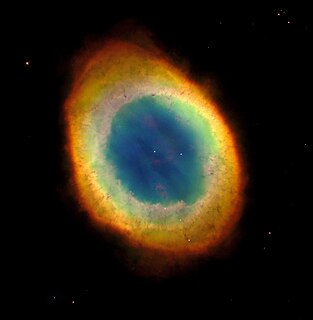
The Ring Nebula is a planetary nebula in the mildly northern constellation of Lyra. Such a nebula is formed when a star, during the last stages of its evolution before becoming a white dwarf, expels a vast luminous envelope of ionized gas into the surrounding interstellar space.

Norma is a small constellation in the Southern Celestial Hemisphere between Ara and Lupus, one of twelve drawn up in the 18th century by French astronomer Nicolas-Louis de Lacaille and one of several depicting scientific instruments. Its name is Latin for normal, referring to a right angle, and is variously considered to represent a rule, a carpenter's square, a set square or a level. It remains one of the 88 modern constellations.

The Triangulum Galaxy is a spiral galaxy 2.73 million light-years (ly) from Earth in the constellation Triangulum. It is catalogued as Messier 33 or NGC 598. The Triangulum Galaxy is the third-largest member of the Local Group of galaxies, behind the Andromeda Galaxy and the Milky Way. It is one of the most distant permanent objects that can be viewed with the naked eye.

The Cat's Eye Nebula is a planetary nebula in the northern constellation of Draco, discovered by William Herschel on February 15, 1786. It was the first planetary nebula whose spectrum was investigated by the English amateur astronomer William Huggins, demonstrating that planetary nebulae were gaseous and not stellar in nature. Structurally, the object has had high-resolution images by the Hubble Space Telescope revealing knots, jets, bubbles and complex arcs, being illuminated by the central hot planetary nebula nucleus (PNN). It is a well-studied object that has been observed from radio to X-ray wavelengths.
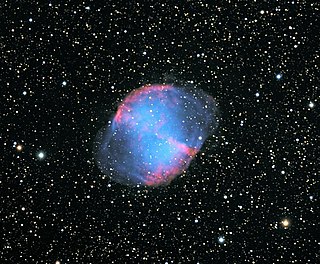
The Dumbbell Nebula is a planetary nebula in the constellation Vulpecula, at a distance of about 1360 light-years. It was the first such nebula to be discovered, by Charles Messier in 1764. At its brightness of visual magnitude 7.5 and diameter of about 8 arcminutes, it is easily visible in binoculars and is a popular observing target in amateur telescopes.

The Eskimo Nebula, also known as the Clown-faced Nebula, Lion Nebula, or Caldwell 39, is a bipolar double-shell planetary nebula (PN). It was discovered by astronomer William Herschel in 1787. The formation resembles a person's head surrounded by a parka hood. It is surrounded by gas that composed the outer layers of a Sun-like star. The visible inner filaments are ejected by a strong wind of particles from the central star. The outer disk contains unusual, light-year-long filaments.

The Stingray Nebula is the youngest-known planetary nebula. The nebula is located in the direction of the southern constellation Ara, and is located 18,000 light-years away. Although it is some 130 times the size of the Solar System, the Stingray Nebula is only about one tenth the size of most other known planetary nebulae. The central star of the nebula is the fast-evolving star SAO 244567. Until approximately forty years ago, it was observed on Earth as a preplanetary nebula in which the gas had not yet become hot and ionized.

Minkowski 2-9, abbreviated M2-9 is a planetary nebula that was discovered by Rudolph Minkowski in 1947. It is located about 2,100 light-years away from Earth in the direction of the constellation Ophiuchus. This bipolar nebula takes the peculiar form of twin lobes of material that emanate from a central star. Astronomers have dubbed this object as the Twin Jet Nebula because of the jets believed to cause the shape of the lobes. Its form also resembles the wings of a butterfly. The nebula was imaged by the Hubble Space Telescope in the 1990s.
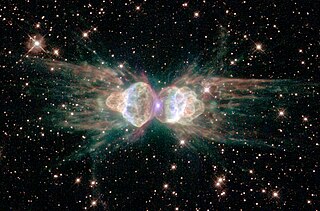
Mz 3 is a young bipolar planetary nebula (PN) in the constellation Norma that is composed of a bright core and four distinct high-velocity outflows that have been named lobes, columns, rays, and chakram. These nebulosities are described as: two spherical bipolar lobes, two outer large filamentary hour-glass shaped columns, two cone shaped rays, and a planar radially expanding, elliptically shaped chakram. Mz 3 is a complex system composed of three nested pairs of bipolar lobes and an equatorial ellipse. Its lobes all share the same axis of symmetry but each have very different morphologies and opening angles. It is an unusual PN in that it is believed, by some researchers, to contain a symbiotic binary at its center. One study suggests that the dense nebular gas at its center may have originated from a source different from that of its extended lobes. The working model to explain this hypothesizes that this PN is composed of a giant companion that caused a central dense gas region to form, and a white dwarf that provides ionizing photons for the PN.

The Little Dumbbell Nebula, also known as Messier 76, NGC 650/651, the Barbell Nebula, or the Cork Nebula, is a planetary nebula in northern constellation Perseus. It was discovered by Pierre Méchain in 1780 and included in Charles Messier's catalog of comet-like objects as number 76. It was first recognised as a planetary nebula in 1918 by the astronomer Heber Doust Curtis. However, there is some contention to this claim, as Isaac Roberts in 1891 did suggest that M76 might be similar to the Ring Nebula (M57), being instead as seen from the side view. The structure is now classed as a bipolar planetary nebula (BPNe), denoting two stars which have burst, leaving neutron star or white dwarf remnants and luminous envelopes. Distance to M76 is currently estimated as 780 parsecs or 2,500 light years, making the average dimensions about 0.378 pc. across.

A protoplanetary nebula or preplanetary nebula is an astronomical object which is at the short-lived episode during a star's rapid evolution between the late asymptotic giant branch (LAGB) phase and the subsequent planetary nebula (PN) phase. A PPN emits strongly in infrared radiation, and is a kind of reflection nebula. It is the second-from-the-last high-luminosity evolution phase in the life cycle of intermediate-mass stars.
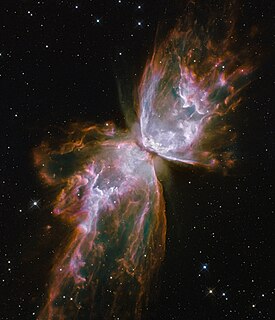
NGC 6302 is a bipolar planetary nebula in the constellation Scorpius. The structure in the nebula is among the most complex ever observed in planetary nebulae. The spectrum of NGC 6302 shows that its central star is one of the hottest stars known, with a surface temperature in excess of 250,000 degrees Celsius, implying that the star from which it formed must have been very large.
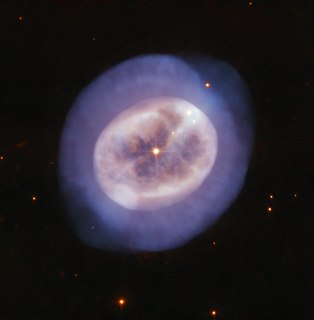
NGC 2022 is a planetary nebula in the equatorial constellation of Orion, located at a distance of 8.21 kilolight-years from the Sun. It was first observed by William Herschel on December 28, 1785, who described it as: considerably bright, nearly round, like a star with a large diameter, like an ill-defined planetary nebula. In medium-sized amateur telescopes it looks like a small grayish patch of light. It is not very bright but it is still easy to spot it in the eyepiece. The object has the shape of a prolate spheroid with a major to minor axis ratio of 1.2, an apparent size of 28″, and a halo extending out to 40″.

NGC 5882 is a small planetary nebula in the southern constellation of Lupus, positioned about 1.5° to the southwest of the star Epsilon Lupi. It was discovered by English astronomer John Herschel on July 2, 1834 from the Cape of Good Hope observatory. John L. E. Dreyer described it as "very small, round, quite sharp". It is located at a distance of approximately 7.7 kilolight-years from the Sun.

NGC 5307 is a planetary nebula in the southern constellation of Centaurus, positioned less than 3° to the northeast of the star Epsilon Centauri. It was discovered by English astronomer John Herschel on April 15, 1836. The nebula is located at a distance of approximately 10.6 kilolight-years from the Sun. The central star, designated PNG 312.3+10.5, is a weak emission-line star, superficially similar to the WC subtype of Wolf–Rayet stars. It has a spectral class of O(H)3.5 V.

RCW 88 is an emission nebula in the southern constellation of Circinus that first appeared in the 1960 astronomical catalogue by Rodgers, Campbell & Whiteoak (RCW) of Hα-emission regions within the southern Milky Way. Earlier observers, like James Wray in 1966, misclassified this as a likely 12.0v magnitude planetary nebula, but later spectroscopic investigations revealed this as a diffuse nebulae. RCW 88 was then to be identified by the infrared satellite IRAS as an HII region.
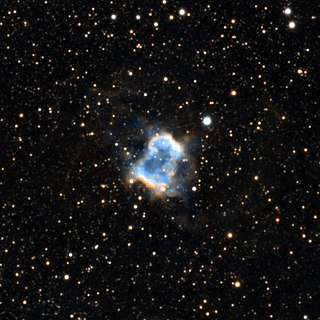
NGC 6445, also known as the Little Gem Nebula or Box Nebula, is a planetary nebula in the constellation Sagittarius. It was discovered by William Herschel on May 28, 1786. The distance of NGC 6445 is estimated to be slightly more than 1,000 parsecs based on the parallax measured by Gaia, which was measured at 0.9740±0.3151 mas.



















